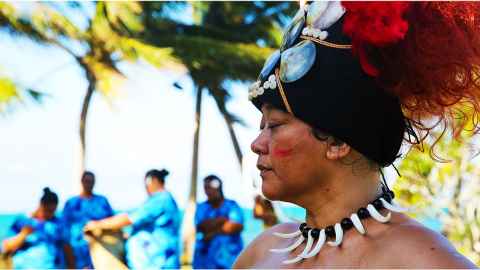Reframing the view
25 June 2019
From early representations of Māori in European art to Disney’s Moana, Indigenous peoples of the Pacific and beyond have been framed and explained by an outsiders’ gaze.

In a collaboration which brings respected Māori, Pacific, North and South American scholars in the field of Indigenous Studies together, the Faculty of Arts is hosting Distentangling the European Gaze, a day-long, free public workshop on Monday 1 July.
Looking through their own lens, speakers with overlapping interests in areas like art history, postcolonial, Māori and Pacific studies, lingustics and comparative literature will deconstruct and critique stereotypical European representations of Indigenous peoples.
Among a range of short presentations, Marina Alofagia McCartney, an award-winning filmmaker and professional teaching fellow in the Arts Scholars programme, will be looking at Pacific filmaking; where it is, where it could go and what would make it different, using her recent film Vai as a case study.
Vai is a portmanteau feature film written and directed by nine Pacific female filmmakers that follows one character played by eight actors connected to the Pacific country in which each vignette is set. The word Vai, in its many versions, also means water in a number of Pacific languages.
Ms McCartney says Vai is the first film ever to have Pacific women in all 'above the line' roles (producer, writer, director) as well as lead acting roles, and was a truly collective effort.
"We turned up at a writer's retreat on Tuesday and by Saturday morning, we had a script. This presents a different view from the auteur theory of filmmaking that involves a film being almost entirely one person’s creative vision; and it became something bigger than any of our individual wants and needs."
Vai is the first film ever to have Pacific women in all 'above the line' roles (producer, writer, director) as well as lead acting roles, and was a truly collective effort.
She says that having been raised in South Auckland by a Geordie father, Samoan mother and Cook Islands stepmother, she is powerfully aware of her cultural heritage and how this affects the way we are viewed and how we view others.
Dr Peter Keegan (Waikato-Maniapoto, Ngāti Porou), a senior lecturer in Te Puna Wānanga at the Faculty of Education and Social Work, will be looking at Aotearoa's Māori language revitalisation efforts, and what insights can be gained from similar efforts around the world.
"Those involved in language revitalisation are very aware that if the language is to survive and be used by the current younger generation (iGen), then it must be able to be used in modern contexts such as the internet," he says, "hence there has been a recent rush to develop speech recognition tools, Māori synthetic voices, AR and VR applications."
However at the same time, Māori is regarded primarily as an oral language and the key mechanism for the retention of Māori cultural values and practices.
"A relatively new approach to revitalisation efforts, my focus is to disentangle the European gaze and seek collaborations with, and insights from, other Indigenous groups around the world; hence events such as the Native American and Indigenous Studies Association (NAISA) conference, recently held in Hamilton, the World Indigenous Peoples Education Conference (WIPCE) and many others."
To register your interest, email organiser Dr Nicole Perry (Cultures, Languages and Linguistics, Faculty of Arts) at nicole.perry@auckland.ac.nz.
Media queries
Julianne Evans | Media adviser
Mob: 027 562 5868
Email: julianne.evans@auckland.ac.nz